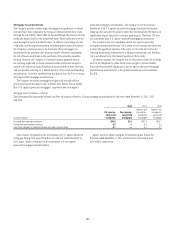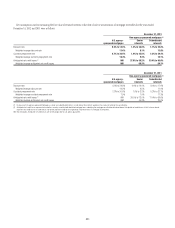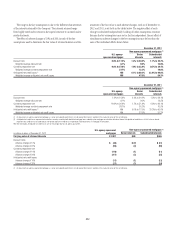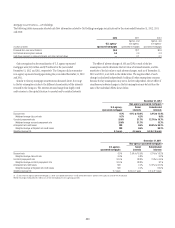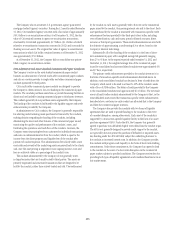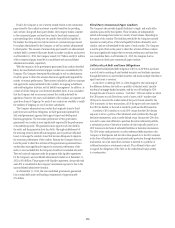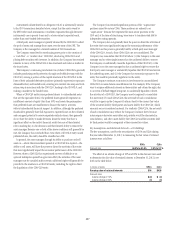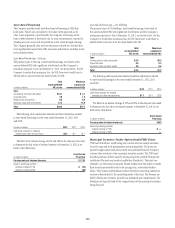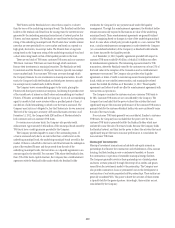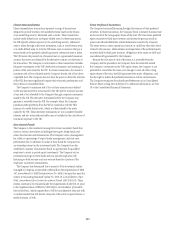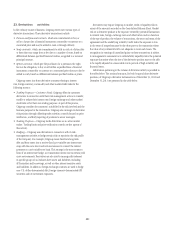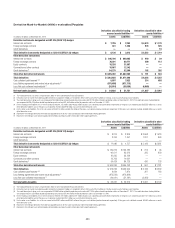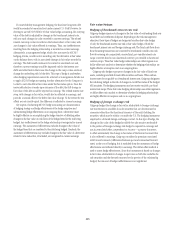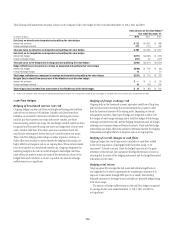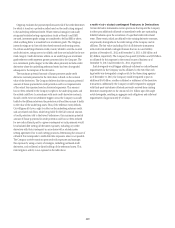Citibank 2012 Annual Report Download - page 261
Download and view the complete annual report
Please find page 261 of the 2012 Citibank annual report below. You can navigate through the pages in the report by either clicking on the pages listed below, or by using the keyword search tool below to find specific information within the annual report.239
The Floaters and the Residuals have a tenor that is equal to or shorter
than the tenor of the underlying municipal bonds. The Residuals entitle their
holders to the residual cash flows from the issuing trust, the interest income
generated by the underlying municipal securities net of interest paid on the
Floaters, and trust expenses. The Residuals are rated based on the long-term
rating of the underlying municipal bond. The Floaters bear variable interest
rates that are reset periodically to a new market rate based on a spread to a
high grade, short-term, tax-exempt index. The Floaters have a long-term
rating based on the long-term rating of the underlying municipal bond and
a short-term rating based on that of the liquidity provider to the trust.
There are two kinds of TOB trusts: customer TOB trusts and non-customer
TOB trusts. Customer TOB trusts are trusts through which customers
finance their investments in municipal securities. The Residuals are held
by customers and the Floaters by third-party investors, typically tax-exempt
money market funds. Non-customer TOB trusts are trusts through which
the Company finances its own investments in municipal securities. In such
trusts, the Company holds the Residuals and third-party investors, typically
tax-exempt money market funds, hold the Floaters.
The Company serves as remarketing agent to the trusts, placing the
Floaters with third-party investors at inception, facilitating the periodic reset
of the variable rate of interest on the Floaters and remarketing any tendered
Floaters. If Floaters are tendered and the Company (in its role as remarketing
agent) is unable to find a new investor within a specified period of time, it
can declare a failed remarketing, in which case the trust is unwound. The
Company may, but is not obligated to, buy the Floaters into its own inventory.
The level of the Company’s inventory of Floaters fluctuates over time. As of
December 31, 2012, the Company held $203 million of Floaters related to
both customer and non-customer TOB trusts.
For certain non-customer trusts, the Company also provides credit
enhancement. Approximately $184 million of the municipal bonds owned by
TOB trusts have a credit guarantee provided by the Company.
The Company provides liquidity to many of the outstanding trusts. If
a trust is unwound early due to an event other than a credit event on the
underlying municipal bond, the underlying municipal bonds are sold in the
market. If there is a shortfall in the trust’s cash flows between the redemption
price of the tendered Floaters and the proceeds from the sale of the
underlying municipal bonds, the trust draws on a liquidity agreement in an
amount equal to the shortfall. For customer TOBs where the Residual is less
than 25% of the trust’s capital structure, the Company has a reimbursement
agreement with the Residual holder under which the Residual holder
reimburses the Company for any payment made under the liquidity
arrangement. Through this reimbursement agreement, the Residual holder
remains economically exposed to fluctuations in value of the underlying
municipal bonds. These reimbursement agreements are generally subject
to daily margining based on changes in value of the underlying municipal
bond. In cases where a third party provides liquidity to a non-customer TOB
trust, a similar reimbursement arrangement is made whereby the Company
(or a consolidated subsidiary of the Company) as Residual holder absorbs
any losses incurred by the liquidity provider.
As of December 31, 2012, liquidity agreements provided with respect to
customer TOB trusts totaled $4.9 billion, of which $3.6 billion was offset
by reimbursement agreements. The remaining exposure related to TOB
transactions, where the Residual owned by the customer was at least 25% of
the bond value at the inception of the transaction and no reimbursement
agreement was executed. The Company also provides other liquidity
agreements or letters of credit to customer-sponsored municipal investment
funds, which are not variable interest entities, and municipality-related
issuers that totaled $6.4 billion as of December 31, 2012. These liquidity
agreements and letters of credit are offset by reimbursement agreements with
various term-out provisions.
The Company considers the customer and non-customer TOB trusts to
be VIEs. Customer TOB trusts are not consolidated by the Company. The
Company has concluded that the power to direct the activities that most
significantly impact the economic performance of the customer TOB trusts is
primarily held by the customer Residual holder, who may unilaterally cause
the sale of the trust’s bonds.
Non-customer TOB trusts generally are consolidated. Similar to customer
TOB trusts, the Company has concluded that the power over the non-
customer TOB trusts is primarily held by the Residual holder, which may
unilaterally cause the sale of the trust’s bonds. Because the Company holds
the Residual interest, and thus has the power to direct the activities that most
significantly impact the trust’s economic performance, it consolidates the
non-customer TOB trusts.
Municipal Investments
Municipal investment transactions include debt and equity interests in
partnerships that finance the construction and rehabilitation of low-income
housing, facilitate lending in new or underserved markets, or finance
the construction or operation of renewable municipal energy facilities.
The Company generally invests in these partnerships as a limited partner
and earns a return primarily through the receipt of tax credits and grants
earned from the investments made by the partnership. The Company may
also provide construction loans or permanent loans to the development or
continuation of real estate properties held by partnerships. These entities are
generally considered VIEs. The power to direct the activities of these entities
is typically held by the general partner. Accordingly, these entities are not
consolidated by the Company.



